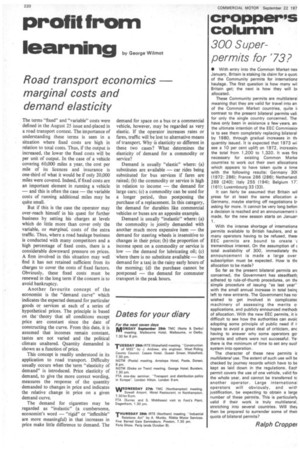profit from
Page 220

If you've noticed an error in this article please click here to report it so we can fix it.
learning by George Wi !mot
Road transport economics marginal costs and demand elasticity
The terms "fixed" and "variable" costs were defined in the August 25 issue and,placed in a road transport context. The importance of understanding these terms is seen in a situation where fixed costs are high in relation to total costs. Thus, if the output is increased, the lower the fixed costs will be per unit of output. In the case of a vehicle covering 60,000 miles a year, the cost per mile of its licences and insurance is one-third of what it would be if only 20,000 miles were covered. Indeed, if fixed costs are an important element in running a vehicle — and this is often the case — the variable costs of running additional miles may be quite small.
But if this is the case the operator may over-reach himself in his quest for further business by setting his charges at levels which do little more than cover only the variable, or marginal, costs of the extra traffic. Thus, where a road haulage business is conducted with many competitors and a high percentage of fixed costs, there is a considerable downward pressure on prices. A firm involved in this situation may well find it has not retained sufficient from its charges to cover the costs of fixed factors. Obviously, these fixed costs must be renewed in the long term if the concern is to avoid bankruptcy.
Another favourite concept of the economist is the "demand curve" which indicates the expected demand for particular goods or services at each of a series of hypothetical prices. The principle is based on the theory that all conditions except price are constant since the date of constructing the curve. From this date, it is assumed that incomes remain constant, tastes are not varied and the political climate unaltered. Quantity demanded is shown as a function of price.
This concept is readily understood in its application to road transport. Difficulty usually occurs when the -term "elasticity of demand" is introduced. Price elasticity of demand, to give the more correct wording, measures the response of the quantity demanded to changes in price and indicates the relative change in price on a given demand curve.
The demand for cigarettes may be regarded as "inelastic" (a cumbersome, economist's word — "rigid" or "inflexible" are more meaningful) in that increases in price make little difference to demand. The demand for space on a bus or a commercial vehicle, however, may be regarded as very elastic. If the operator increases rates or fares, traffic will be lost to alternative means of transport. Why is elasticity so different in these two cases? What determines the elasticity of demand for a commodity or service?
Demand is usually "elastic" where: (a) substitutes are available — car rides being substituted for bus services if fares are raised; (b) the commodity or service is high in relation to income — the demand for large cars; (c) a commodity can be used for a longer period, thus postponing the purchase of a replacement. In this category, the demand for durables like commercial vehicles or buses are an apposite example.
Demand is usually "inelastic" where: (a) the commodity is jointly demanded with another much more expensive item — the demand for steering wheels is insensitive to changes in their price; (b) the proportion of income spent on a commodity or service is low — the demand for lubricating oil; (c) 'where there is no substitute available — the demand for a taxi in the rainy early hours of the morning; (d) the purchase cannot be postponed — the demand for commuter transport in the peak hours.
































































































































































































































































































































































































































































































































